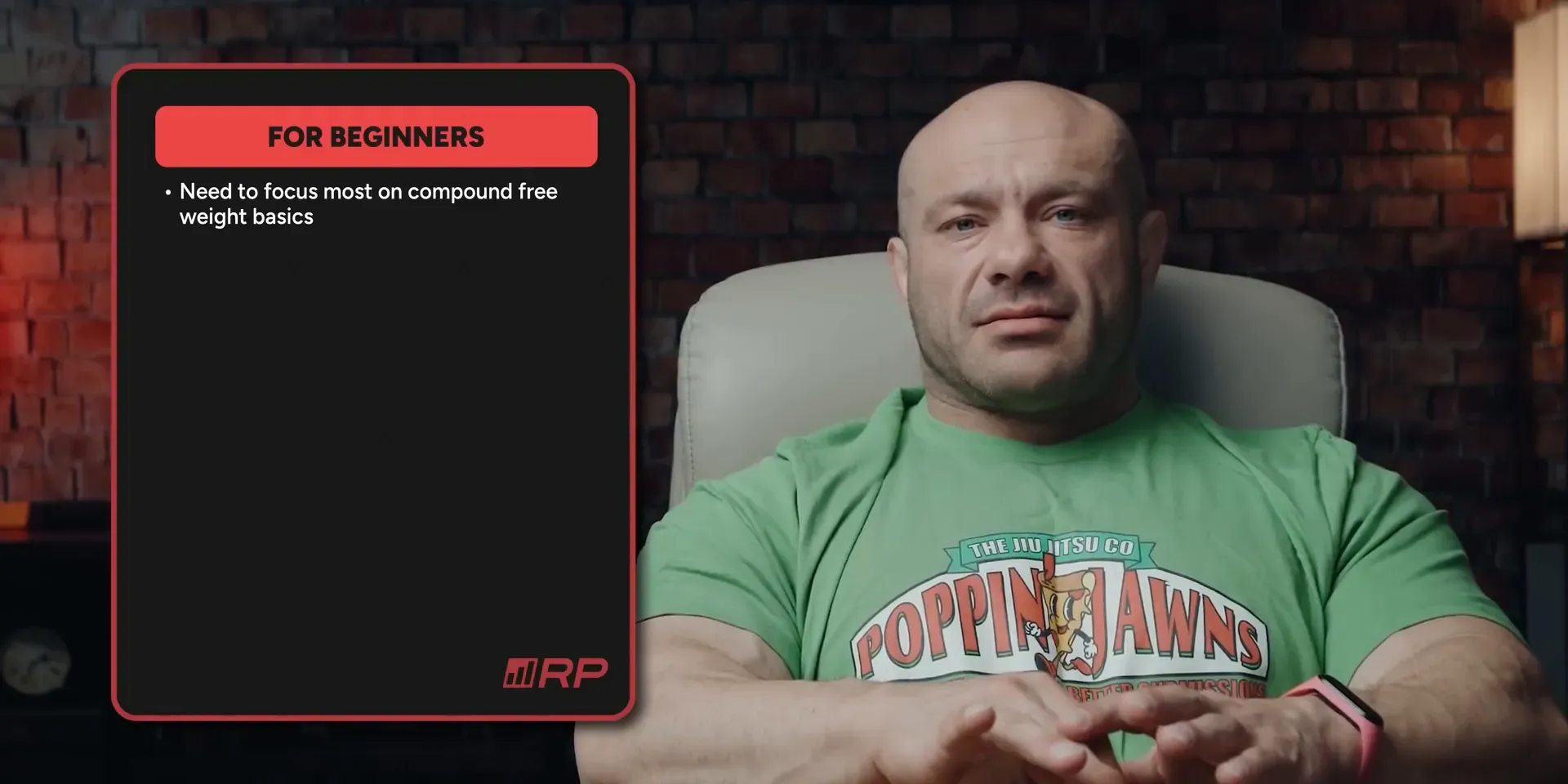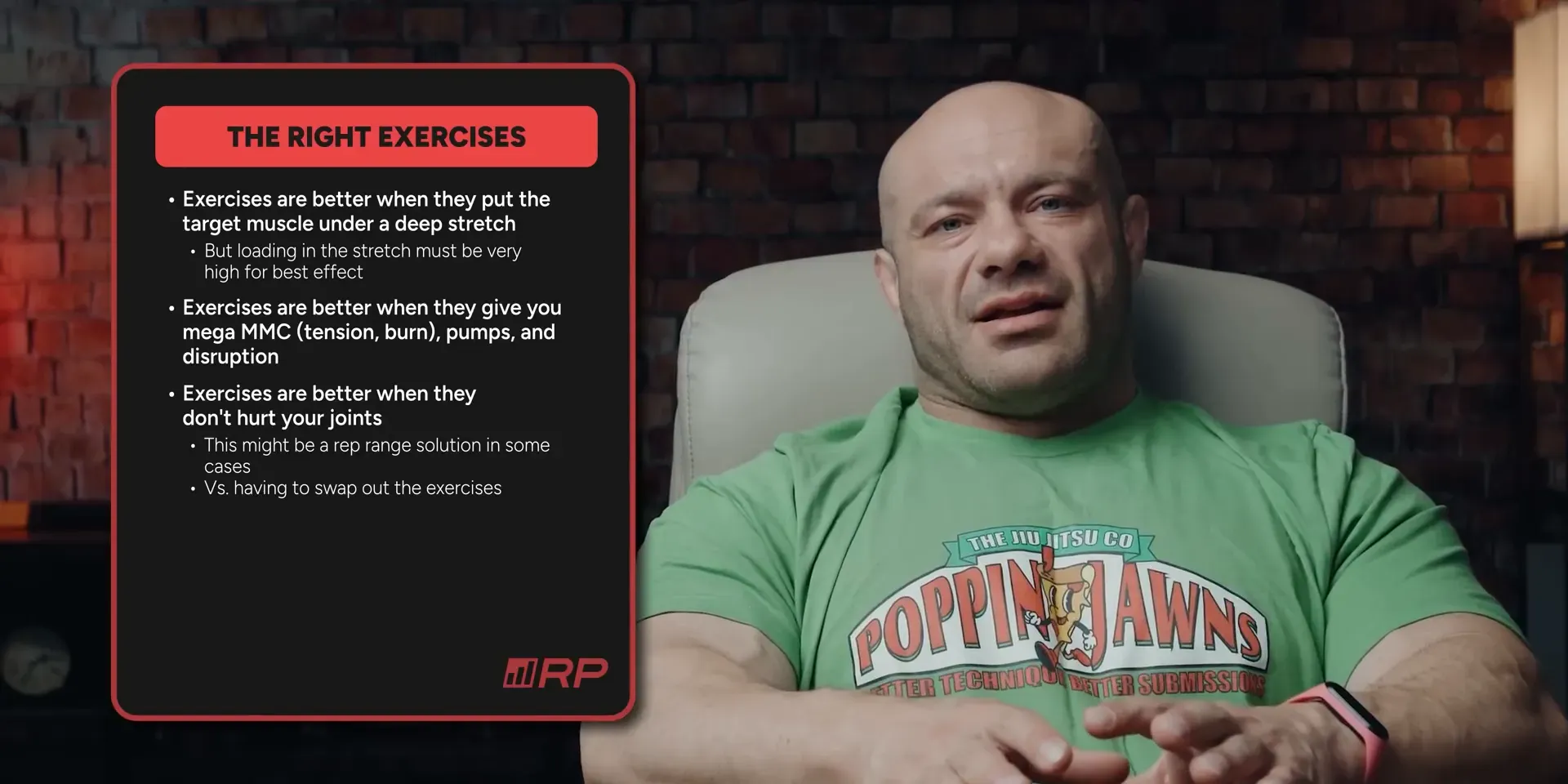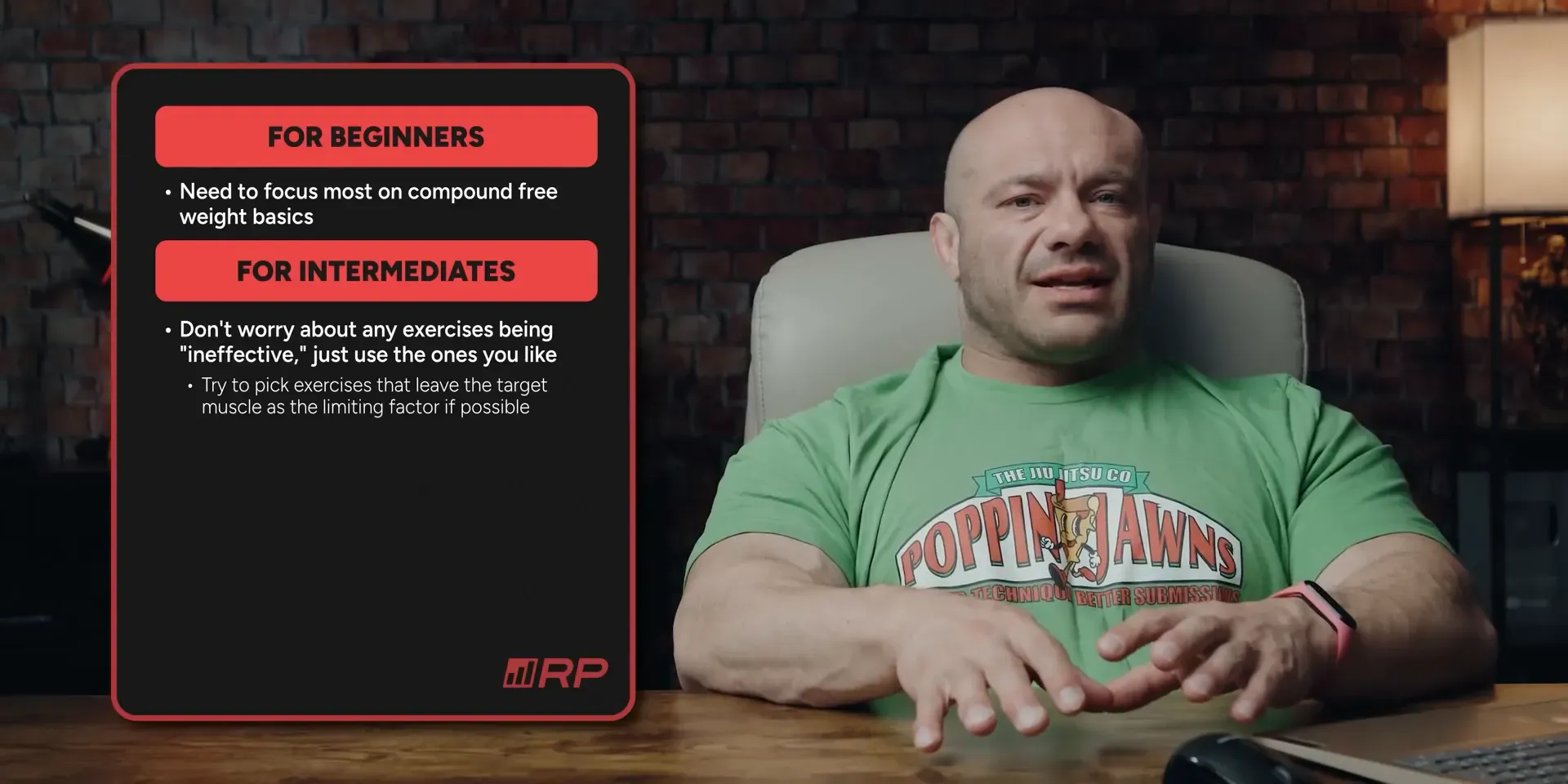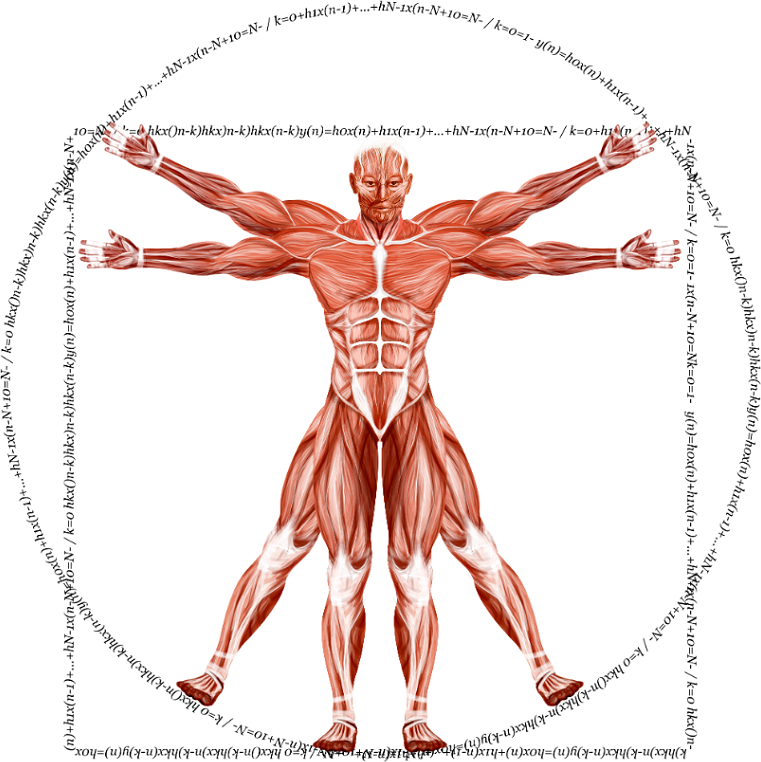Good Exercises for Muscle Gain: Expert Guide [In-depth]
Build strength and size with the best exercise selection for gym workouts, according experts
![Good Exercises for Muscle Gain: Expert Guide [In-depth]](/content/images/2025/04/baf0de24-7a7c-4ff8-8cec-75ef2b5cfab6-1.png)
Key Takeaways:
- Compound Exercises as Building Blocks: For beginners, foundational moves like squats, push-ups, and deadlifts are essential for developing balanced strength and muscle mass.
- Variety Encourages Growth: As experience increases, diversifying exercises with different angles or stretches can improve muscle engagement and combat training plateaus.
- Precision for Long-Term Progress: Advanced lifters should rotate exercises periodically and fine-tune their routines to focus on growth without risking burnout.
- Mind-Muscle Connection is Key: Actively engaging the target muscle throughout each rep boosts effectiveness, especially in isolation exercises aimed at enhancing muscle growth.
- Protect Joints with Smart Exercise Selection: Choose movements that engage muscles while maintaining joint health, ensuring sustainable progress without injury.
Want to master the most effective exercises for building quality muscle while avoiding common mistakes that slow your progress?
In this expert review, we analyze, critique, and expand on Dr. Mike Israetel's approach to exercise selection, providing you with a clear roadmap to faster, more consistent gains.
Why should you listen to us? Unlike typical workout guides, our content is thoroughly reviewed and fact-checked by fitness experts, including an exercise scientist with over 20 years of real-world experience. We reveal hidden techniques for optimizing muscle growth, enhancing recovery, and achieving your dream physique more efficiently.
Ready to take your training to the next level? Let's get started.
Related:
- How to Build Muscle: Beginner's Guide for Optimal Gains
- Hypertrophy Training: Exercises & Workout for Muscle Gain
- 7-Day Bodybuilding Meal Plan: Foods to Eat & Avoid for Muscle Gain
In a Nutshell—Good Exercises for Muscle Gain: Maximizing Your Workout Potential
• Once lifters advance to the intermediate stage, incorporating variations—such as new grips or slight adjustments in angle—helps break through plateaus by emphasizing muscle fatigue.
• Advanced lifters, who require precise targeting to sustain growth, should focus on a core rotation of high-impact exercises that minimize joint strain.
Tailoring these exercises to specific goals and employing a full range of motion with proper tension ensures both muscle engagement and systemic recovery. Regardless of experience, prioritizing form, muscle activation, and joint health keeps gains steady and sustainable.
| Key Concept | Main Insight |
|---|---|
| Foundation in Compound Exercises | Compound moves build a strong base for beginners. |
| Variety for Continued Growth | Mixing angles and grips prevents plateaus and enhances muscle targeting. |
| Exercise Precision for Progress | Tailored routines help advanced lifters sustain gains without burnout. |
| Mind-Muscle Engagement | Focus on the target muscle for better activation and growth. |
| Joint-Friendly Exercise Choices | Select exercises that support joint health to avoid injuries. |
Introduction to Exercise Selection

Selecting the right exercises is the foundation of effective muscle gain. Choosing exercises that align with your muscle goals can seem overwhelming, with a plethora of trends and conflicting advice from influencers. But here's the secret: focus on the basics that consistently deliver results. This guide dives into the essentials of exercise selection and practical, science-backed advice to help beginners, intermediates, and advanced lifters maximize muscle growth and achieve sustainable gains.
The Science Behind Exercise Selection
Understanding the science behind effective exercises is key to optimizing results. Regardless of movement type, the goal remains to engage and grow muscles efficiently. For example, using bodyweight exercises can be incredibly effective as they recruit multiple muscles for stabilization and balance, especially important for men aiming to build strength without equipment.
- Full Range of Motion: Exercises that allow for full range and deep stretch typically yield better muscle engagement, maximizing fiber recruitment and growth.
- Tension Application: Maintaining consistent tension on the muscle group is a major factor for muscle hypertrophy, regardless of whether weights or bodyweight is used.
Exercise Selection for Beginners
Beginners should prioritize foundational, compound exercises, which can include weighted moves and bodyweight exercises, to effectively build strength and muscle. Compound exercises engage multiple muscle groups and increase movement proficiency, creating a strong foundation for future progress.
- Key Exercises: Squats, deadlifts, push-ups, pull-ups, and bench presses provide an excellent starting point.
- Bodyweight Options: Consider bodyweight squats, lunges, push-ups, and pull-ups as some of the best bodyweight exercises for muscle gain for men without equipment.
- Consistency Over Complexity: Avoid advanced, specialized moves at this stage; focusing on fundamentals reduces injury risks and builds a solid muscle base.
Exercise Selection for Intermediate Lifters
As you gain experience, experimenting with new exercises becomes beneficial. Intermediate lifters can add variation to their routine by incorporating different angles, grips, and exercise styles, helping target muscles differently and avoid plateaus.
- Variety for Growth: Try exercises with a loaded stretch to maximize tension without compromising joint comfort, as this is especially effective for both fat loss and muscle gain.
- Focus on Limiting Factors: Choose exercises that allow the target muscle to exhaust first, supporting better engagement.
- Enjoyment and Consistency: Continue incorporating exercises that you enjoy, as this is key to maintaining long-term progress.
Exercise Selection for Advanced Lifters
Advanced lifters require precision and thoughtful exercise selection to sustain growth. A “top five” list of exercises for each muscle group can optimize your training without causing excessive fatigue.
- Exercise Rotation: Rotate exercises based on training cycles to maintain effectiveness and prevent overuse injuries.
- Customization and Fine-Tuning: Include exercises tailored to your specific goals and refine your routine to sustain progress.
- Adaptation for Goals: Adjust exercises to your current goals, balancing muscle engagement with systemic recovery.
Best Body weight Exercises for Muscle Gain for Men

For those preferring to work without equipment, body weight exercises offer powerful results by using one’s body as resistance. These exercises build strength and muscle mass while enhancing functional fitness and balance.
- Push-Ups: Ideal for chest, shoulders, and triceps. Variations like decline push-ups add further challenge.
- Pull-Ups: Effective for upper back and biceps, with close and wide grips for added variety.
- Pistol Squats: A challenging leg exercise, building strength in quadriceps, hamstrings, and glutes without weights.
- Planks: Strengthen core muscles and improve stability, especially beneficial for compound movement support.
Common Exercise Selection Mistakes
Avoiding common mistakes in exercise selection ensures your workouts remain productive. For example, many assume only gym-based movements lead to muscle gain or that bodyweight exercises lack effectiveness.
- Flexibility: No exercise is indispensable; find what suits your body type and goals.
- Consistency Over Novelty: Frequently switching exercises can hinder progress, so focus on mastering basics and make changes only as needed.
- Thoughtful Experimentation: While experimenting with exercises, prioritize consistency to see results from proven movements.
The Importance of Exercise Selection
Exercise selection is a critical factor in any training program. Choosing the right movements can maximize your muscle growth and enhance your overall performance. It’s not just about doing the most popular exercises; it’s about finding what works best for your body.
Every exercise has its purpose. However, some movements are more beneficial for specific goals. For instance, if your aim is to build strength, compound exercises like squats and deadlifts are essential. They engage multiple muscle groups and promote hormonal responses that are crucial for muscle growth.
On the other hand, if you want to target specific muscles, isolation exercises come into play. They allow you to focus on muscles that may need extra attention. The key is to balance both types of exercises in your routine.
Moreover, understanding how different exercises affect your body is vital. Some movements may feel great but might not provide the best stimulus for growth. Always pay attention to how your body responds to different exercises.
The Role of Muscle Limiting Factors
To maximize growth, select exercises that allow the target muscle to fully fatigue rather than stopping due to grip or balance limitations. This applies to weighted movements as well as bodyweight exercises like push-ups, which can be adjusted to allow the target muscle to tire fully.
- Example: If grip fatigue limits your ability to complete rows, consider machine rows to allow for better back engagement.
- Bodyweight Considerations: For push-ups, ensure form consistency so that the target muscle group fatigues before any other part.
Importance of Stretch and Tension
Maintaining muscle tension throughout an exercise increases growth potential, especially in isolation moves. Bodyweight exercises for muscle gain without equipment can particularly benefit from a controlled approach that emphasizes muscle stretch and tension.
- Isolation Exercises: Bicep curls or hamstring stretches require a controlled stretch for effective engagement.
- Full Range of Motion: Fully engaging the muscle promotes fiber recruitment, supporting enhanced growth.
Mastering the Mind-Muscle Connection
The mind-muscle connection—actively feeling the target muscle work—is vital for optimal muscle activation in each rep. For instance, in exercises for fat loss and muscle gain, ensuring the correct muscle is engaged maximizes effectiveness and can boost muscle retention during fat loss phases.
- Focus on Target Muscles: For example, if you’re working glutes but feel it in your quads, re-evaluate your form.
- Building Muscle Activation: Over time, consistent engagement and focus improve the effectiveness of each exercise.
Understanding Disruption and Muscle Growth
Muscle disruption indicates how much stress an exercise places on the muscle, often felt as soreness or fatigue. While some soreness is normal and supports growth, avoid exercises that only cause discomfort without yielding results.
- Balance Soreness and Recovery: Soreness can be a growth signal, but excessive pain without growth suggests an ineffective approach.
- Modify When Needed: If a move causes joint pain without muscle gains, adjust to protect health and sustain progress.
Joint Health and Smart Exercise Selection
Joint health is crucial, especially for exercises that require stability under body weight. Painful movements should be modified or replaced to avoid injury and ensure longevity in training.
- Pain-Free Alternatives: If knee discomfort arises from squats, consider bodyweight exercises like step-ups or lunges.
- Protective Movement: Choose exercises that strengthen muscles while protecting joint health, particularly in bodyweight routines.
Effort vs. Systemic Fatigue
Systemic fatigue hinders overall performance across workouts. Localized fatigue (targeting specific muscles) is preferable for muscle growth and sustainability. A balance between muscle engagement and recovery prevents burnout, especially important in high-repetition bodyweight exercises for muscle gain.
Choosing exercises you enjoy leads to consistent, quality workouts. Over time, enjoyment contributes to steady progress and better adherence to a fitness routine.
Experimentation for Intermediate Lifters

Experimentation is beneficial at the intermediate level, fostering gains through novel moves and variations. Bodyweight exercises, such as different push-up or squat variations, can introduce a loaded stretch and prolong tension on muscles.
- Loaded Stretch Focus: Lunges or bodyweight squats emphasize a stretch that supports muscle growth.
- Track and Refine: Regularly track results, refining your favorite movements for continued gains.
Top Exercises for Advanced Lifters
Advanced lifters benefit from a top five list of exercises for each muscle group, chosen for their effectiveness and low fatigue. These exercises sustain growth while reducing systemic stress, suitable for intense bodyweight or weight-based routines.
- Exercise Rotation: Regularly rotate movements to maintain muscle engagement without risking overuse.
- Precision and Efficiency: Adjust your choices based on personal goals and training cycles for optimal outcomes.
Final Thoughts and Recommendations
Exercise selection is critical in achieving muscle gain for beginners, intermediates, and advanced lifters. Beginners should focus on compound movements, adding complexity gradually. Intermediate lifters can experiment with bodyweight exercises for muscle gain for men, including no-equipment options. Advanced lifters benefit from refining a core list of effective exercises, maintaining growth while managing fatigue.
- Listen to Your Body: Prioritize exercises that deliver results while preserving joint health. Consistency with routines that yield pump and soreness indicates engagement and growth.
Practical Applications
- Prioritize Compound Movements: Begin each workout with compound exercises like squats, deadlifts, or bench presses to engage multiple muscle groups and boost overall strength. Aim for 3-4 sets of 8-12 reps.
- Add Variety for Muscle Growth: To avoid plateaus, introduce variations in grip, angle, or stance every 4-6 weeks. For example, switch from regular pull-ups to neutral-grip pull-ups to engage the back muscles differently.
- Implement Full Range of Motion: Ensure each exercise moves through its full range to maximize muscle activation. In a squat, aim to lower until your thighs are parallel to the ground or beyond, completing 8-12 reps per set.
- Consistent Tension for Hypertrophy: For muscle growth, maintain tension throughout each movement, especially in isolation exercises. Perform movements like bicep curls slowly and with control, keeping tension for 3-4 sets of 10-15 reps.
- Exercise Rotation for Advanced Lifters: For advanced lifters, rotate a select few high-impact exercises every 8-12 weeks to prevent overuse injuries and sustain muscle growth.
Examples:
- Beginner: Start with 3 sets of 10 reps of squats, deadlifts, and push-ups to build foundational strength and endurance.
- Intermediate: Incorporate incline bench presses or close-grip pull-ups every few weeks to target chest and back muscles from new angles.
Fact-Check of Key Points
- Foundation in Compound Exercises: The emphasis on compound movements as the best foundation for beginners is generally accepted in fitness. However, some experts suggest that incorporating isolation exercises early on may also benefit specific muscle groups and correct muscle imbalances, offering a more customized approach to individual needs.
- Bodyweight Exercises vs. Weighted Movements: The article suggests bodyweight exercises are beneficial but best used alongside weights for optimal muscle gain. This view is widely held, yet some argue that advanced bodyweight moves (like single-arm push-ups or pistol squats) can be just as effective as weights for building strength and muscle, especially for those focused on functional fitness.
- Rotation of Exercises for Advanced Lifters: While rotating exercises to prevent overuse is a recommended strategy, some professionals believe that advanced lifters can still make progress by sticking with core exercises and adjusting variables like volume or intensity instead of constantly rotating exercises.
- Emphasis on Full Range of Motion: Advocating for a full range of motion aligns with many training philosophies, yet some coaches suggest that partial ranges can be beneficial for specific goals, like targeting a particular muscle area or avoiding joint strain. This nuance could have been acknowledged, as both full and partial ranges have their respective advantages depending on the context.
Science of Optimal Exercises for Muscle Gain
Research demonstrates that effective muscle gain primarily relies on progressive resistance training (RT) strategies, optimal protein supplementation, and high-intensity protocols to maximize muscle hypertrophy. Meta-analyses reveal key insights into the most effective approaches:
- Protein Supplementation with Resistance Training (RT): Protein supplementation significantly enhances muscle mass and strength gains during RT, particularly in younger individuals. A protein intake around 1.6 grams per kg per day is most effective, with minimal benefits beyond this level (Morton et al., 2017), (Cermak et al., 2012).
- Eccentric vs. Concentric Exercise: Eccentric (lengthening) exercises are more effective than concentric (shortening) exercises for muscle strength and size, particularly at high intensities. The load exerted in eccentric actions uniquely stimulates muscle cross-sectional area, likely due to neural adaptations specific to eccentric movements (Roig et al., 2008).
- Single vs. Multiple Sets: Multiple sets per exercise are superior to single sets in achieving muscle hypertrophy. Specifically, 2–3 sets yield significantly higher muscle growth compared to single sets, with 4–6 sets offering incremental yet less substantial improvements (Krieger, 2010).
- Moderate vs. Heavy Loads: Moderate to heavy loads (about 80% of one-repetition maximum) are especially effective in promoting muscle strength and hypertrophy among older adults, and RT with higher load intensity generally results in more significant gains in muscle mass across age groups (Csapo & Alegre, 2016).
Practical Applications of Science
- Program Design: Use multiple sets (2-3) with moderate to high loads for optimal gains.
- Eccentric Emphasis: Include eccentric movements to maximize muscle size gains.
- Protein Timing: Ensure protein intake meets daily requirements around 1.6g/kg to support RT adaptations.
Scientific Conclusion
High-intensity, multi-set, and protein-supplemented resistance training is highly effective for muscle hypertrophy, particularly when incorporating eccentric movements and moderate-to-heavy loads.
More Little-Known Tips for Effective Muscle Gain
- Prioritize Progressive Overload in Every Workout: Consistently adding weight, reps, or intensity pushes muscles to adapt and grow. Aim to increase load in small increments every few sessions. For bodyweight exercises, add extra reps, or use pauses at peak contraction points to add intensity.
- Use Rest-Pause Sets for Tough Exercises: Rest-pause sets help you push through plateaus by taking brief breaks within a set. Complete as many reps as possible, pause for 10-15 seconds, and continue. This technique is effective in moves like pull-ups or bench presses, where adding more reps can be challenging.
- Focus on Eccentric Muscle Actions: The eccentric (or lowering) phase of a movement is key to muscle growth. Lower weights slowly—taking 3-5 seconds—during exercises like curls or squats. This prolonged tension breaks down more muscle fibers, leading to greater gains during recovery.
- Try Pre-Exhaust Sets for Target Muscle Activation: In compound exercises, supporting muscles often tire first. To prevent this, do a light isolation exercise, like leg extensions, before squats. This fatigues the target muscle slightly, enhancing its activation during the main lift.
- Don’t Underestimate Recovery Tactics: Muscles grow outside the gym, so use tools like foam rolling, stretching, and quality sleep to aid recovery. Incorporating active recovery days with light cardio or yoga also promotes blood flow, helping repair muscles faster.
Muscles grow outside the gym, so use tools like foam rolling, stretching, and quality sleep to aid recovery. Incorporating active recovery days with light cardio or yoga also promotes blood flow, helping repair muscles faster.
My Opinion on Good Exercises for Muscle Gain
I believe that when it comes to muscle gain, the best results come from focusing on a solid foundation of compound movements. While it’s tempting to jump into trendy, complex routines, I find that sticking to proven basics like squats, deadlifts, and bench presses is more beneficial, especially for beginners. These exercises not only build muscle but also help establish the strength and coordination needed to handle more advanced movements later on.
Some might argue that isolation exercises and advanced techniques should be introduced early to maximize muscle growth, but I disagree. In my experience, adding complexity too soon can lead to improper form and increased risk of injury. Instead, I recommend prioritizing consistency in fundamental exercises, which strengthens joints and muscles gradually, setting up a safer path for progress.
I also understand the appeal of bodyweight exercises and their role in muscle gain, especially for those without access to gym equipment. I believe they’re incredibly useful and can provide results when applied correctly, but I feel they’re best supplemented with weights for well-rounded development. Relying solely on body weight, in my opinion, may limit potential gains over time, particularly for those aiming to build larger muscle mass.
In the end, effective muscle gain requires a focus on foundational exercises, strategic variations, and steady progressions. This is why I recommend tools like the Dr. Muscle app, which automates and personalized exercise choices, ensuring you’re on the right track at every stage.
Concluding: Mastering Muscle Gain Exercises
In sum, selecting the right exercises is fundamental to effective muscle gain at any stage of training. Beginners benefit from mastering compound movements to create a strong foundation, while intermediate and advanced lifters gain by incorporating variety and precision. Exercise selection that emphasizes full range of motion, consistent muscle tension, and safety ensures that every workout contributes meaningfully to long-term progress and muscle health.
For those looking to streamline and enhance their fitness journey, the Dr. Muscle app offers an ideal solution. Dr. Muscle automates exercise selection, tracks your progress, and continuously adapts to your evolving fitness level—all without the guesswork. Whether you’re a beginner establishing a foundation or an advanced lifter fine-tuning routines, try Dr. Muscle to get a personalized path to maximize gains.
FAQ
Q: How often should I change my exercises?
Ans: Introducing new exercises every few months can prevent plateaus, though foundational movements should remain.
Q: Are isolation exercises important?
Ans: Yes, isolation exercises target specific muscles, though compound moves are generally more effective for overall muscle gain.
Q: What if an exercise hurts my joints?
Ans: Avoid it; explore alternatives that deliver muscle benefits without joint strain.
Q: How can I tell if an exercise is effective for me?
Ans: Look for muscle pump and mild soreness. Track progress to determine long-term effectiveness.
Q: Should I prioritize weight or form?
Ans: Form is key for muscle activation and injury prevention; never sacrifice it for added weight.

